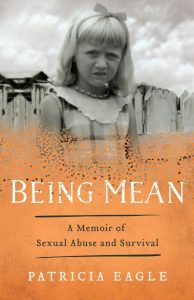Techniques for Flexing Memory Muscles
 After writing my memoir, Being Mean: A Memoir of Sexual Abuse and Survival, one question I have been asked frequently is, “How can you remember details from so long ago?” Excavating our life experiences can indeed be a challenging and illuminating experience. But certain practices have helped hone my memory muscles, allowing me to dig beneath layers I am living and have lived.
After writing my memoir, Being Mean: A Memoir of Sexual Abuse and Survival, one question I have been asked frequently is, “How can you remember details from so long ago?” Excavating our life experiences can indeed be a challenging and illuminating experience. But certain practices have helped hone my memory muscles, allowing me to dig beneath layers I am living and have lived.
Journals
Journaling can become a handy container for memories. Journals can be places where we write about things from the past as often as the present, and also where we ruminate about the future. Such a reflective habit reinforces details from the writer’s pespective. And it’s not just what is written and read later that reinforces memory. I discovered that the process of writing about something, even if I never look at that journal entry again, helps strengthen my memory.
My first writing was at eight years old, when I kept a diary for my dog, A Little Dabb’ll Do Ya (Dabb for short). I wrote about Dabb’s friends, his favorite toys, and things we did together. It was an innocent way to enter into a diary habit that was acceptable by my mother, who may have feared I might write about the sexual abuse happening in our home at that time. By my twenties, I was journaling regularly, as I still do. Journaling became my go-to place for reflections on the past, present, and future. These are in no way literary works, rather a place where I process, pray, plan, ponder, and remember.
Life Timeline
In the process of writing my memoir, I also chose to create a timeline of my life––a massive endeavor that required utmost patience, long walks, stretches of meditative silence, and, lucky for me, six decades of a journaling practice. I decided to put myself in a unique environment that would allow me to feel comforted as I did the digging. I arranged for eight days of silence in a monastery––a solitary “cell,” meals prepared, natural beauty all around me, with monks chanting at intervals throughout the day. Wouldn’t an archeologist thoughtfully prepare her site for digging just as carefully?
I brought two tri-fold display boards, drew straight lines across the top and bottom, then started filling in the years, with my age next to each year. I made a long list of what I wanted to remember: every move I had made, places lived, schools attended, all the jobs and career changes, dogs, lovers, illnesses, accidents, mystical experiences, travels, influential teachers and/or workshops, births, deaths, and more. My memory muscles were stimulated, challenged, and exhausted. It was as though my life became an onion with each individual layer, each year lived, slowly peeled back. My eyes watered plenty.
Perpetual Calendar
With things I couldn’t remember, when I returned home I checked my hallway crammed with what I call “perpetual calendars.” Each day I fill in a calendar square with something significant or inconsequential: a major diagnosis, a bird I saw, guests, the first or last snow. Each month I flip every calendar’s page. Periodically my spouse or I stop and remind the other of something that happened on that day two or ten years ago. “Really, was it that long ago?” or “Really, that was only last year?” we might respond. This is a practice that allows for an interesting perspective of time, nudging our memories to tenderly cradle days, months and years as life progressses in real time, whether it feels like it’s creeping along or zipping by.
Automatic Writing
Another technique I discovered indirectly. I decided to hone my listening skills by talking less and quietly listening. Soon I started hearing more than words. What would happen if I did this while writing? Before my sexual abuse memories surfaced, I had scenes flash in my head, often triggered by a sound, how something felt, a smell: a shower curtain being pulled back, something scratchy, the smell of Dial soap. There were experiences I needed to excavate, but when I sat down with a pen and paper, or my laptop and an analytical mind, I felt stuck.
Tired of sitting at my desk, one day, without a concrete plan, I moved to my bed with my laptop, propped myself up, then became still and quiet. A memory of trying to jump out of my dad’s eighteen-wheeler while it was moving had stayed with me for decades. Why had I done that? Why had I been crying? With my eyes closed, my fingers began typing. I let the memory and details that had been buried deep creep to the surface. When the experience felt like too much, I sat still––heart aching and hands resting on my computer––until my fingers began moving again. No pressure. I was safe, alone, comfortable, Kleenix handy. I changed little in that piece, nor others that followed, using this technique I now call automatic writing. By chance I had discovered a method for inviting memories I had avoided into the present moment.
Whether journaling, life time-lines, perpetual calendars, or automatic writing, exploring methods that enhance and encourage memory retreival can be valuable for a memoirist or anyone wishing to enrich and expand their perspective on a life lived.
—
A Life-Cycle Celebrant® and story gatherer, Patricia Eagle maintains an unyielding commitment to excavating and acknowledging what is resilient about her life and the lives of others. She lives in southern Colorado and is the author of Being Mean: A Memoir of Sexual Abuse and Survival, published June 11, 2019 by She Writes Press.
About BEING MEAN
 In this richly depicted story, told in vignettes relative to markers of age and experience, Patricia Eagle reveals the heartbreak and destruction of her sexual abuse, from age four to thirteen, by her father. A victim of her father’s anger and her mother’s complacency with his abusive behavior, Eagle uses dissociation and numbing in response to the abuse, and as a way to block her own sense of self.
In this richly depicted story, told in vignettes relative to markers of age and experience, Patricia Eagle reveals the heartbreak and destruction of her sexual abuse, from age four to thirteen, by her father. A victim of her father’s anger and her mother’s complacency with his abusive behavior, Eagle uses dissociation and numbing in response to the abuse, and as a way to block her own sense of self.
How does a child confused by episodes of abuse come to know what is safe or unsafe, right or wrong, normal or abnormal? How does a young woman learn the difference between real love and a desire for sexual pleasure stimulated by abusive childhood sexual experiences? Careening through life, Eagle wonders how to trust others and, most importantly, herself. As a mature woman struggling to understand and live with her past, she remains earnest in her pursuit of clarity, compassion, and trust to build a stronger life.
Being Mean is about blocking sexual abuse memories, having them surface, then learning how to acknowledge and live with incomprehensible experiences in the healthiest ways possible.
Category: On Writing
























